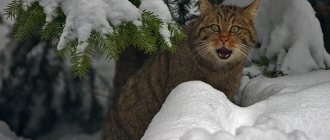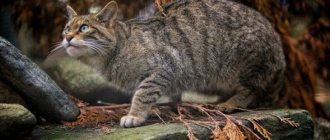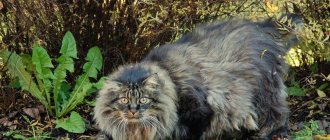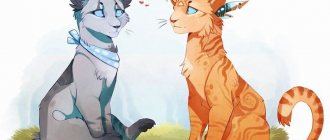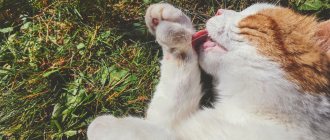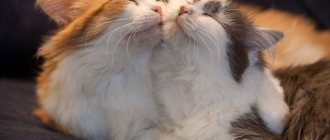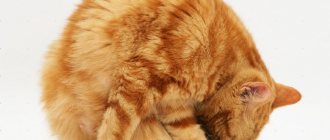The Far Eastern forest cat is a close relative of the Bengal cats that are so popular today and live in the territory adjacent to it. Amur cats, as they are also called, are the smallest representatives of the cat family in Asia.
These cats are so secretive and cautious that their exact numbers still remain a mystery to researchers. The species is listed in the Red Book as endangered and is protected by the state.
Appearance
The Amur forest cat is only slightly larger in body size than domestic cats. The entire adult male usually does not exceed 6-8 kg, especially large specimens can weigh up to 15 kg. Females are more graceful and noticeably smaller.
- The body length of a wild cat can reach 90 cm, with at least 1/3 of it being the tail. The average tail length of the individuals that naturalists were able to measure is 35-37 cm.
- The body of the Far Eastern wild cat is elongated, strong and well-built.
- The head is small compared to the body, the tail is thin and long.
- The ears are small, widely set, slightly tilted forward, which is typical for many felines, and there are no tassels at the ends.
- The eyes, on the contrary, are large and expressive, located close to each other.
- The nose is wide, flat with a brown nose. The vibrissae pads are well defined and complement a strong and rounded chin.
Although the Far Eastern cat is similar to domestic tabby cats, few of them can boast such a fluffy and warm coat. The fibers of its dense fur can reach a length of 5 cm.
Color of Far Eastern cats
The smallest among Asian cats, they have a protective coloring that makes them almost invisible among trees and shrubs. The upper part of the body is darker, the basic tone can vary from grayish-yellow to gray-brown.
Along the ridge there are 3 longitudinal stripes of brown color, formed by the merging of narrow spots. In some individuals these stripes merge into one wide one. The throat under the chin is decorated with 4-5 transverse stripes of reddish-brown color.
There are clear stripes on both the forelimbs and the muzzle. The thin and elegant tail is usually colored in a single color in reddish or black-gray, but there are also contrasting rings in black or gray.
Dark red spots, blurry or clearly defined, are scattered throughout the body. In the abdomen and groin area they are lighter.
This coat color is reminiscent of ancient Chinese coins, which is why in the Celestial Empire Amur forest cats are called “money cats.”
Varieties
In the natural world there is a wide variety of species of wild cats that live in different parts of the vast planet. Many species of big wild cats are listed in the Red Book, as there is a threat of extinction. The names of wild cats are different, but they are united by one cat genus.
Caucasian
The Caucasian forest cat lives in the Caucasus mountains at an altitude of up to two kilometers, the number of individuals is only 100. As a result, the species is included in the Red Book.
The color is dominated by brown shades - the skin is reddish-brown with gray leopard spots. The wild Far Eastern cat prefers night hunting and impenetrable wilds and thickets.
Amursky
The Amur cat is a type of Bengal cat. It has thick grayish-brown fur with dark red spots. It lives along the Amur River and near the Sea of Japan. He is also known as the Far Eastern forest cat.
Reed
This Russian forest cat is found in the Astrakhan region of Russia. External characteristics greatly distinguish it from other forest wild cats.
This animal has powerful paws, a small tail and large ears, at the tip of which there are small tassels reminiscent of the tassels of a lynx. In this regard, it is also called the “swamp lynx”. As can be seen from the second name, it prefers reed thickets along rivers and swamps.
Although the places where swamp lynxes live are located near human habitation, they are quite suspicious and do not approach people. This species of cat is listed in the Red Book.
But since catching a European forest cat is a rather difficult task, the survival of the species is guaranteed by the presence of trees on which wild cats climb well.
Lifestyle and nutrition
The Far Eastern forest cat leads a solitary life, gathering in groups of several individuals only during the mating period. One individual usually covers 4-9 km²; it does not leave this territory and guards the boundaries of its property. Migrations occur only in the absence of the proper amount of food.
Within its territory, the cat has several shelters, which are rock crevices hidden from prying eyes by thickets of bushes, abandoned badger and fox holes, and hollows of old trees. In favorable times, the animal periodically visits all its makeshift homes, but for the winter it remains in the warmest and most protected one.
During periods of prolonged snowfall, the Amur cat may not leave its home for weeks, waiting for the weather to improve and crust to form. Their paws are not adapted to move on loose snow, and their modest size makes this activity almost impossible.
They begin to hunt at dusk, waiting for prey in ambush on a tree or in the bushes. Surprisingly, a Far Eastern cat only needs one precise jump to overtake an unfortunate mouse or squirrel.
The diet of this predator consists of small mammals such as hares, chipmunks, and mouse-like rodents. The forest cat also hunts birds, often destroying their nests and feasting on eggs. Sometimes it attacks small ungulates - young roe deer and deer, and catches fish.
In addition to the above, the Amur cat can eat frogs and other amphibians, as well as insects. He does not disdain the remnants of the feast of his larger brothers - the leopard or the tiger.
The lifestyle and character of the Far Eastern forest cat have been little studied, since this animal is very secretive and tries to avoid human habitation. However, in particularly harsh winters it can come close, trapping rodents in barns and stealing poultry.
In case of danger, the Amur cat hides in a tree, but if a skirmish cannot be avoided, it defends itself very fiercely and does not retreat, even if the enemy surpasses it in size and strength.
Life with a man
But, despite the fact that keeping Amur cats at home and buying and selling transactions are prohibited, and failure to comply with this ban is subject to a fine of up to a million rubles. This does not stop some, and exotic lovers strive to acquire an unusual predatory cat, challenging their wild nature. From time to time there are advertisements for the sale of such cats, the price for them reaches one hundred thousand rubles, but keeping such a pet will cost even more.
In such cases, it is necessary to remember that his predatory nature will not go away and will not become an affectionate kitten, and sometimes this can even become dangerous.
If you still manage to get such a cat at home, you need to follow some recommendations.
- Create a free enclosure for the cat, with equipment for jumping and climbing.
- Feed your pet once a day, preferably at the same time.
- The diet should include poultry, lean beef, veal and rabbit, and don’t forget about mice.
- Sometimes you can give your pet fish, boiled vegetables and eggs.
- Once a week, do a fasting day for the cat.
- Provide the cat with toys: balls, mice.
It has been proven that even if you take a newly born kitten and try to tame it, nothing will work, the hunting instincts will make themselves felt, and the animal will want to go into the wild. Even after a long stay in captivity, the cat will be able to easily adapt to the forest and will not disappear.
The Amur forest cat is a unique subspecies of the cat family. Nature has rewarded it with an unusual coloring, tenacious paws, a strong body and a death grip. Listing in the Red Book protects the cats’ habitat and species. Despite warnings and fines, they still try to domesticate wild cats, sometimes without creating the necessary living conditions and putting themselves in danger.
Feeding in captivity
The main food of the Far Eastern forest cat in captivity is lean meats, such as beef, but without live food - rats, mice, day-old chicks and quails, it is difficult to maintain normal physiological activity and reproduction of animals, especially since the behavioral characteristics of the predator are dulled, which leads to " obsessive movements”, boredom of the animal. In addition, the animal eats not only fresh meat, but also the contents of the intestines, the brain, and part of the skin with wool (feather) of “live” food. It is believed that to complete protein metabolism, it is advisable to offer fish once a week. But not all the time. Excess fish in the diet can lead to the leaching of calcium from the animal’s body and, accordingly, to associated diseases, such as rickets.
For daily feeding of a Far Eastern forest cat, 2 mice, or one rat and about 200 grams are enough. lean meat. Feed once a day.
An equally important component of feeding is a weekly fasting or “fasting” day, when the animal (except for females during lactation and kittens up to six months of age) is not given meat or live food. However, some experts, once a week, in addition to the “hungry” day, arrange a “half-starved” day, when the norm of meat or live food is given at half the norm
This is important, since in captivity cats do not expend energy as intensively as in the wild and therefore often become fat, get sick and even die.
When keeping cats indoors, in good weather it is necessary to periodically walk them outdoors. On the street, the cat receives natural ultraviolet light (which is extremely necessary for the production of vitamin D, which in turn has a positive effect on health), feeds on meadow grass (looking for the necessary herbs for the body), and gets acquainted with new smells. Walking “domestic” cats is important for the full physical and psycho-emotional development of the animal.
Life expectancy in captivity is 20 years.
Reproduction
According to some sources, Amur cats reach sexual maturity at the age of 8-10 months, according to another version only at 1.5 years. As expected, the breeding season of the leopard cat is in March. Some experts claim that these animals are monogamous, although this is not typical for cats.
If two gentlemen are courting a female, skirmishes and fights between them cannot be avoided. Fights are accompanied by hissing and wild screams, the winner gets the right to mate and procreate, the loser leaves.
Kittens are born after 65-70 days, usually 1-2, less often 4. Newborn kittens are blind and helpless, their weight is only 70-80 g. At first, they spend most of the day sleeping, waking up only to eat. Both parents look after the babies. The female is constantly on the alert, and sensing the slightest danger, she takes them to another place.
Kittens grow quickly and already at 1.5 months they get out of the shelter to explore the surrounding area. Young cats do not stay near their mother any more than necessary. At the age of 6-7 months, they finally leave their parents’ den and go in search of their own hunting grounds.
Diseases and health problems
Evolution and natural selection in conditions of constant frost have formed good immunity in the Norwegian breed. Human intervention in this process made its own adjustments. These cats are prone to a number of diseases:
- Restructive cardiomyopathy. Deterioration in the elasticity of the muscle tissue of the heart, as a result of which heart failure develops, which can cause the death of the animal.
- Diabetes and other endocrine system disorders.
- Arthrosis of the hip bones.
- Retinal dysplasia. It is an abnormal formation of the structure of the layers of the retina, which occurs in the prenatal period.
- Chronic renal failure.
- Glycogenosis. The disease disrupts metabolic processes in the liver. Typically, kittens with this disease are born dead or nonviable. Some individuals can live up to 4-6 months.
- Purivate kinase deficiency. A decrease in the number of red blood cells in the blood and the development of anemia.
The last two diseases are rare. Professional breeders, in order to avoid such consequences, conduct special blood tests, and are also picky about the choice of partners for mating.
Amur forest cat in captivity
The Far Eastern forest cat is kept in some zoos, but even with everyday interaction with people, it is absolutely not amenable to domestication. They reproduce well in captivity, but they are always wary of humans.
Forest cats are fed once a day with live small rodents and birds. The life expectancy of the Amur cat in the natural environment is 8-10 years, in captivity up to 17 years.
At home, the Amur forest cat can only be kept in a spacious enclosure. Even if you take a kitten 3 months old and raise it in a family, the animal will pose a danger as an adult. Particularly aggressive behavior is observed in cats during periods of acute sexual desire.
Description. Breed standard
The photo of forest cats presents us with an animal similar to ordinary gray domestic pets.
However, they have a larger body, reaching 4–8 kg. Under natural conditions, their weight depends on the season, availability of prey and age. An old cat in winter will weigh several times less than a well-fed young cat in the warm season. Weight ranges from 2.5–5.9 kg for females and from 3.5–8 kg for males. Moreover, a wild forest cat is inferior in size and weight to individuals living in captivity, especially if they have been castrated or sterilized. The body dimensions of this cat breed are as follows:
- females are approximately 75–80 cm long and 40 cm high at the withers;
- males reach a length of 90 cm and a height of up to 43 cm.
The forest cat lives quite a long time, up to 15 years in the natural environment and up to 30 years at home, in captivity. This period exceeds the life expectancy of ordinary cats.
In appearance, at first glance, a wild European cat is difficult to distinguish from a domestic one. Taking a closer look, discrepancies become noticeable. So, a forest dweller’s tail has a blunt end, it is shorter than that of a domestic cat, and fluffier. The shedding of a wild animal is more noticeable: in winter its fur is uniform, thick, fluffy and shiny. Shedding occurs in spring until May, in autumn until November. The track of a forest cat is identical to that of a domestic cat, but is slightly larger. The hind paws have four toes, the front paws have five. Sharp claws retract.
The forest cat has medium-sized, wide-set ears. The ears do not have tassels and can rotate to identify the direction of sound. The vision is stereoscopic, there are no eyelashes. Yellow-green eyes have a third eyelid - a nictitating membrane that performs a protective function. Forest animals have well-developed vision and hearing, while their sense of smell is slightly weaker. The teeth are sharp and small.
A wild cat makes sounds and screams similar to the screams of domestic pets, usually during mating periods; the rest of the time it is silent. But at the moment of aggression or attack, she can hiss, howl and whistle. The main enemies of forest cats are lynx, fox, marten, jungle cat, wolf and jackal, hawk and owl.
For habitat, the forest cat prefers:
- mixed and broad-leaved forests (chooses remote areas, climbs trees well);
- rocky and rocky areas of mountains (rises to heights of 3000 m above sea level);
- near rivers it settles in reed thickets.
In nature, the predatory forest cat feeds on small animals (hares, shrews, rabbits and moles), rodents (rats, nutria, mice, muskrats, voles), fish, lizards and snakes. He will not refuse plant food - leaves of some plants. Does not disdain mollusks, insects and crayfish. It can easily cope with ermine, weasel, marten and ferret. Of the larger animals, it attacks roe deer or chamois calves left without parental care.
Status and protection
The Amur forest cat is listed in the Red Book of the Russian Federation and is protected by the international CITES Convention as an endangered species. Nowadays, according to researchers, the population of wild cats has begun to grow.
In our country, Far Eastern cats inhabit several biosphere reserves:
- Cedar Pad (Primorsky Territory);
- Khankaisky (Primorsky Territory);
- Ussuriysk (Primorsky Territory);
- Lazovsky (Primorsky Territory);
- Bolshekhehtsirsky (Khabarovsk Territory).
The main threat to cats in the Far East is the reduction of natural habitats due to deforestation. Another important factor is the possibility of crossing with an ordinary domestic cat, as a result of which the genetic purity of the species is lost.
Bengal cat
In Western countries, Bengal cats are called leopard cats, so sometimes there can be confusion as there is a special type of domestic cat, also called Bengal. Wild representatives of this breed of cats live in the southern and eastern regions of Asia. The Bengal cat population of the Indonesian islands of Sumatra and Borneo has recently been developed into a separate species called the Zunda Bengal cat.
With a body length of 65 centimeters, this cat ranks third among the smallest wild animals in Asia. Bengal cats are excellent at climbing trees, hunting their inhabitants, insects and small rodents. The population of this species is considered quite stable, so it is listed as Least Endangered on the IUCN Red List.
Most national parks on the island of Borneo in Indonesia boast the presence of a Bengal cat, which thrives in the wild, but under the supervision of animal control.
8
Habitats
The Amur forest cat, like many other inhabitants of the Far East, is endemic. It is not found anywhere else. This predator inhabits the entire length of the Amur River, on the coast of the Sea of Japan, in the area of lakes Khanka and Khasan, on the Hindustan Peninsula, as well as practically throughout the entire territory of China up to the Malay Islands.
He feels especially comfortable in nature reserves: Khankaisky, Ussuriysky, Lazovsky, Kedrovaya Pad. This is explained not so much by safety (the Amur cat has never been hunted on an industrial scale), but by the distance from human settlements.
This predator is also found on some of the Japanese islands. In fact, this is where one of its names came from: “Leopard Cat of Tsushima.”
It lives mainly in grassy floodplains, deciduous or mixed forests. It is less common in the taiga, although even there you can see its spotted skin. In Pomorie, its main habitat is shrubs and reed lowlands along the banks of oxbow lakes and lakes. In these places you can often find the name “reed cat”: it is not entirely correct, since a completely different representative of the cat family has the same name, but it well reflects the lifestyle of the Amur predator.
The Far Eastern cat feels quite confident on the rocks, although it does not climb high into the mountains. The reason for this is the snow that accumulates between the stones in winter (the maximum depth of snow cover at which a predator can hunt is 30-40 cm).
With the beginning of winter, the cat hides in the nest and does not leave it until a strong frozen crust forms on the surface of the snow, capable of supporting the weight of the animal. The only exceptions are cats feeding their cubs, and those of their cats who were unlucky in hunting before the blizzard.
Leopard cat color
A “leopard” cat has very soft hair, with a dense, thick undercoat. The color of the skin can vary from grayish-sandy to yellow-brown, with oval-shaped reddish spots scattered throughout the body. Because of these spots, reminiscent of ancient coins, the Chinese nicknamed the predator “Money Cat.”
On the back, dark specks merge into three black-brown stripes. The same stripes, only transverse, can be seen on the cat’s paws and throat. In young animals, the leopard coloring is more pronounced, but with age the color becomes more even.
On the belly of all representatives of this species the fur is lighter than on the ridge (in the area of the chest and throat it approaches dirty white). But the tail, on the contrary, is almost always monochromatic, reddish-gray or brown. The tip is painted dark gray or black. Sometimes you can see dark stripes ringing it.
The head of a forest cat is decorated with two lighter stripes running from the inner corners of each eye. Between them, from the red-gray nose through the top of the head, a brown stripe stretches to the neck. The animal’s chin is almost white, but the tips of the ears, on the contrary, are painted black. In general, the brown-striped color serves as excellent protection for Amur cats, making it almost invisible both on the branches of a tree and on the ground covered with leaves.
